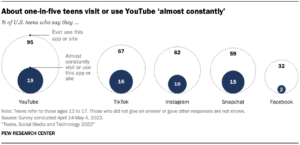
Pew Research Explores Where and How Often Teens Go Online for Content
Pew Research has explored what American teenagers are watching online, which can be of value to merchandisers, parents and educators. Pew’s survey also tracked how often teens are online, which will be of interest to federal and state regulators and lawmakers.
YouTube easily tops the list of online platforms preferred by teens, followed by TikTok and Snapchat. Instagram, Facebook, WhatsApp, Twitter and Reddit have much smaller teen patronage.

The Pew survey interviewed 1,435 teens between the ages of 13 and 17 who say they view online sites or apps. The survey found 93 percent of the teens surveyed go to YouTube, 63 percent to TikTok and 60 percent to Snapchat. Pew’s survey summary didn’t include clues as to what online content drew teens online and to individual platforms.
Use of YouTube is uniformly high among boys and girls, all ethnicities and the full age range of teens in the survey. It also doesn’t vary based on household income or urban, suburban or rural locations. Teens treat YouTube like adults treat television.
There is more variability among TikTok users. Teen girls use it more than boys, Black teens use it substantially more than their Hispanic and white counterparts. Older teens use it more than younger teens.
Snapchat usage is more uniform, though teen girls use it more than teen boys and older teens more than their younger peers. There are minor usage differences among ethnic groups, household incomes and community types.
Use of YouTube is uniformly high among boys and girls,
all ethnicities and the full age range of teens.
 Frequency of Checking In
Frequency of Checking In
A total of 71 percent of teens surveyed admitted to checking in on YouTube daily. The comparable percentages for TikTok (58 percent), Snapchat (51 percent) and Instagram (47 percent) also were substantial, suggesting more than half of teens are glued to social media.
Seventeen percent of surveyed teens said they are on TikTok “almost constantly” compared to 16 percent on YouTube, 14 percent on Snapchat and 8 percent on Instagram. The data showed 22 percent of girls, 32 percent of Hispanics, 31 percent of low-income teens and 22 percent of urban teens confessed they are constant users.
Historical Trend Lines
While YouTube is the runaway teen favorite among online platforms, Pew researchers only began tracking it in 2022. The same is true for TikTok, WhatsApp, Twitch and Reddit. Other sites such as Instagram, Facebook and Twitter have been benchmarked by Pew since 2015.
Both YouTube and TikTok registered slight declines in teen use in 2023. Both Instagram and Snapchat have gained substantial usage since 2015. The platform with the biggest drop-off is Facebook, which went from a 71 percent use rate in 2015 to 33 percent in 2023. Twitter (X) dipped from 33 percent in 2015 to 23 percent in 2023.
YouTube Content
Music videos are the most popular content on YouTube, according to online sources. Based on teen testimonials, short videos are their content of choice. YouTube also happens to be the second most used search engine.
One informed YouTube viewer said the platform’s popularity stems from its direct tie to the Google search engine, gigantic storage and bandwidth and huge traffic flows that number in the billions. However, the same viewer warned YouTube could lose its teen appeal if overtaken by “big monied advertisers”.
Other YouTube draws for teens include vloggers, DIY videos and skin care videos. Some teen users say they search for advice on how to deal with depression, anxiety and being an outcast at school. A notable number use it to shop online.
 An Investment in Branding
An Investment in Branding
Thought Leaders, an influencer marketing firm, ties YouTube’s popularity to short-form videos, which it says account for the site’s 122 million daily viewers and 2.7 billion monthly check-ins.
“You may be saying to yourself – so what? Teens aren’t spending a big chunk of money on products and services they see online. True, but [Pew Research] clearly shows that teens on the verge of adulthood (having a job, making money, shopping for themselves) are comfortable/already influenced by YouTube. The more we can learn about teenagers’ online behavior, especially on social media platforms, the better we can plan future social media marketing and brand sponsorships.”
Online Child Privacy Protection
How young children and teenagers are influenced online has prompted the Federal Trade Commission to propose updates to child online safety rules and led to several states enacting or considering child online safety legislation.
Psychologists and parents express concern about the addictive quality of online content, as well as inappropriate content that can be exposed to young people. Proposals have ranged from more parental control to built-in safeguards for online platforms. Skeptics question whether controls will be effective.




